February 19th, 2008
admin
Sources: Dailytech, xenu.net
The Church of Scientology is a vicious and dangerous cult that masquerades as a religion. Its purpose is to make money. It practices a variety of mind-control techniques on people lured into its midst to gain control over their money and their lives. Its aim is to take from them every penny that they have and can ever borrow and to also enslave them to further its wicked ends.
Demonstrations occurred in a reported 93 cities worldwide, including Sydney, Los Angeles, New York, London, Dublin, and Stockholm. Donning signs with slogans such as “Knowledge is Free,” “Question $cientology,” and “Enlightenment should not cost £100,000,” Anonymous took a vocal stand against the Church of Scientology’s alleged human rights violations and relentless suppression of dissent. Demonstrations proceeded peacefully, with protesters concealing themselves behind Guy Fawkes masks – among other things – as popularized in the movie “V for Vendetta.”

February 19th, 2008
admin
Source: Dailytech
British scientists reported last week that they successfully created human embryos from the DNA of not two, but three people — two women and a man. Researchers tried to downplay concerns of ethics with genetic modification, citing that the embryos chiefly consist of the DNA from one man and one women, but contain select segments from the other women.
February 19th, 2008
admin
Source: Anandtech
Click the link for the full review

February 19th, 2008
admin
Source: Dailytech
Scientists use nanogenerators in fabric to generate electricity
A group of scientists in the United States has a plan that will boost the run time of small gadgets like phones a MP3 players to possibly unlimited proportions, without the need for batteries. The scientists hope to do this with fabric that generates its own electricity.
The idea is that fiber-based nanogenerators would be woven into the fabric of a shirt and the friction cause by moving around would be transferred into energy to power the device. Scientists even say that simply standing in a breeze could generate all the power your iPod needs to play indefinitely.
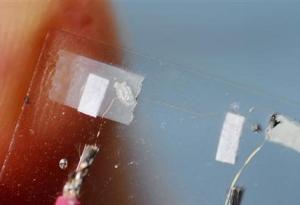

February 19th, 2008
admin
Source: Dailytech
Samsung announced in a press release that its 1.8-inch and 2.5-inch 64GB SSD with a SATA II interface is now in the mass production stage. The new SATA II version of the drive was announced in Q4 2007 and is said to remove the bottlenecks of the PATA interface used in the previous version of the drive.
According to the director of Samsung Semiconductor’s flash marketing department, “While there will always be a market for HDDs, we see growing demand for our new SSDs, especially now that they are available with the SATA II interface.”

February 19th, 2008
admin
Source: Sharp develops new laser to enable recording of dual layer Blu-ray discs at 6x
Sharp has unveiled new technology which will definitely make things better for media geeks in coming months. Reportedly the firm has developed a new type of laser that enables recording of dual layer Blu-ray discs at 6x speed. The new laser achieves highest industry standards of 250mW output pulse and comes in small package of 3.3mm diameter for use in laptops.
February 19th, 2008
admin
Source: Dailytech
Clone your beloved Snookums for a mere $150k
Cloning is a subject of much debate here in the United States, therefore, we don’t hear of the cloning of animals by American scientists much. However, the process of cloning animals is done in other countries.
A Korean company called RNL Bio is working with the scientists who cloned the first canine named Snuppy. The company is offering to clone deceased pets for the tidy sum of $150,000. A company spokeswoman says that the first customer, Bernann McKunney from California, has already signed up to have her dead pit bull cloned.
February 19th, 2008
admin
Source: Dailytech
NVIDIA’s purchase of AGEIA leads to a PhysX-on-CUDA port
With the announcement earlier this month of NVIDIA’s acquisition of AGEIA, rumours began to fly immediately surrounding the future of dedicated physics hardware — and it now appears that the PhysX name will live on as a checkbox beside the capabilities of some current and most future NVIDIA GPUs.
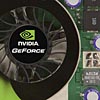
February 19th, 2008
admin
Source: BBCNews
Rocky planets, possibly with conditions suitable for life, may be more common than previously thought in our galaxy, a study has found.
New evidence suggests more than half the Sun-like stars in the Milky Way could have similar planetary systems.
There may also be hundreds of undiscovered worlds in outer parts of our Solar System, astronomers believe.

February 19th, 2008
admin
Source: BBCNews
A giant cloud of hydrogen gas is racing towards a collision with the Milky Way, astronomers have announced.
Dubbed “Smith’s Cloud”, it may set off spectacular fireworks when it smacks into our galaxy in 20-40 million years.
It contains enough hydrogen to produce a million stars like our Sun, researchers believe
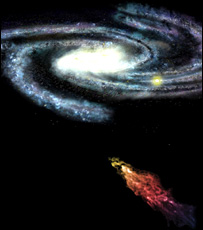

February 19th, 2008
admin
Source: Yahoo News
US researchers have created a nano-fiber textile that harvests energy from movement, paving the way for clothing that could one day power an iPod or other wearable electronic devices, according to a study published Wednesday.
Using the same mechanical principle as a self-winding watch, but on scale measured in billionths of a meter, tiny nano-generators can scavenge “wasted” energy from sound waves, vibrations, or even the human heart beat.
The fibers, developed by a team of scientists at the Georgia Institute of Technology led by Zhong Lin Wang, are covered with pairs of zinc oxide nanowires that produce tiny pulses of electricity in response to friction.
February 19th, 2008
admin
Source: Dailytech
Stanford University researchers design the first GHz chip using carbon nanotubes
Carbon nanotubes are being used in all sorts of research thanks to their strength and much higher electron mobility. Scientists are looking to carbon nanotubes as a replacement for copper wire in circuits, seen to be a bottleneck in future chips.
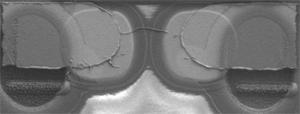

February 19th, 2008
admin
Source: BBCNews
UK scientists hope to mend shattered bones and damaged cartilage using a patient’s own stem cells.
They are developing a “bioactive scaffold” to protect the stem cells and encourage them to grow into bone or cartilage when placed in the body.
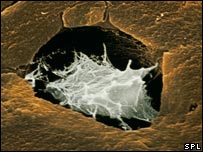
February 19th, 2008
admin
Source: BBCNews
Humans and machines would eventually merge, by means of devices embedded in people’s bodies to keep them healthy and improve their intelligence, predicted Mr Kurzweil.
“We’ll have intelligent nanobots go into our brains through the capillaries and interact directly with our biological neurons,” he told BBC News.
CHALLENGES FACING HUMANITY
Make solar energy affordable
Provide energy from fusion
Develop carbon sequestration
Manage the nitrogen cycle
Provide access to clean water
Reverse engineer the brain
Prevent nuclear terror
Secure cyberspace
Enhance virtual reality
Improve urban infrastructure
Advance health informatics
Engineer better medicines
Advance personalised learning
Explore natural frontiers
The nanobots, he said, would “make us smarter, remember things better and automatically go into full emergent virtual reality environments through the nervous system”.

February 19th, 2008
admin
Source: physorg.com
If you could hold a giant magnifying glass in space and focus all the sunlight shining toward Earth onto one grain of sand, that concentrated ray would approach the intensity of a new laser beam made in a University of Michigan laboratory.
“That’s the instantaneous intensity we can produce,” said Karl Krushelnick, a physics and engineering professor. “I don’t know of another place in the universe that would have this intensity of light. We believe this is a record.”
The pulsed laser beam lasts just 30 femtoseconds. A femtosecond is a millionth of a billionth of a second.
Such intense beams could help scientists develop better proton and electron beams for radiation treatment of cancer, among other applications.
The record-setting beam measures 20 billion trillion watts per square centimeter. It contains 300 terawatts of power. That’s 300 times the capacity of the entire U.S. electricity grid. The laser beam’s power is concentrated to a 1.3-micron speck about 100th the diameter of a human hair. A human hair is about 100 microns wide.














Recent Comments